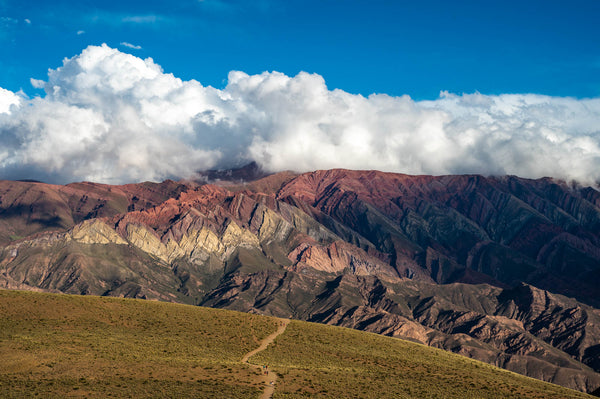NORTHERN ARGENTINA - A report by Paolo Penni Martelli
A trip to Northern Argentina, between desolate lands and breathtaking landscapes. What you will read are notes, excerpts, flashes that Paolo Penni Martelli wrote for us. Even in front of the screen, we wish you a good journey.

I had never pedaled beyond the 2758m of the Stelvio and already there, I remember that as soon as I tried to accelerate or push the pedals standing up, everything started to go out of speed, I was out of breath and my heart was bouncing randomly in my chest. In short, being born 500m above sea level and having spent the last 14 years of my life in Barcelona would not have helped me much to face what awaited me.
I would have followed, physically and photographically, the adventure and the journey of 15 people through Northern Argentina, starting from Salta, to enter the Andes. We would have faced the famous Cuesta de Lipan, 4170m, then El abra del Infiernillo, over 3000m, and finally "El Hornocal" over 4300m. About 950 km in ten days with more than 12,000 meters of elevation gain.


We leave on February 10th, the month of fevers for the Po Valley, while in Argentina it represents the height of summer; but experience teaches and four years ago I learned the hard way, in Patagonia, that summer in South America can be something very far from what we Europeans are used to: the four seasons can go hand in hand and dance together, taking turns within 24 hours.
My biggest concern, in addition to how the body would have reacted at those altitudes, was the weather: all our equipment would have to occupy the space of a small backpack, like those at the limit of the Ryanair fine at the airport. I was more ready and prepared in the cold than in the heat. You manage the heat, you suffer the cold.
However, the weather seems to be merciful: the first two stages of the approach run smoothly, with a real summer heat that allows us to travel quite light, despite the weather on the phone predicting clouds and rain every day. Fortunately, however, meteorologists are confirmed to be far from infallible.
We cross tiny villages, many of which proudly display signs with the name of the Inca populations from which they derive: the Tupac Amaru, who I remember from my school studies as one of the indigenous peoples who tried to rebel against the Spanish conquest until the last minute.

The third stage is the one that from Purmamarca will take us up towards the over 4000m of the Cuesta de Lipan. There are 35 km of ascent, going from 2300 to 4170m. I wake up rested on average and strangely relaxed, what awaits me is a real challenge; the day before I tried and mascato for a few hours the famous coca leaves that should cushion the blow of possible altitude sickness.
The Puna is called, the dreaded altitude sickness of the Andes. All altitude sickness is different and it doesn't matter if you've already covered the five thousand meters ten times, he hits you when and how he feels like it and, apparently, the Puna likes to play with anyone and at any time. My climb will last around 5 hours, including all breaks to eat and do my work, photos!
Breath good, oxygen good, legs good. My head instead starts throbbing around 3800m, it starts from the neck, from behind, goes up and reaches the forehead. It is annoying and obviously continues to increase with physical effort. I do the last km walking with the bike by hand, in silence, kissed by a cold wind on my face.
The last effort is to have me take a picture right on the brow, before launching myself downhill as fast as possible, towards Las Salinas, at 3600m: a salt lake of volcanic origin. The pressure in my head drops quickly and I only think about filling my eyes with the beauty that surrounds me.

The Puna made me feel nauseous and unwell for three hours, but the human body is a beautiful machine and has the ability to recognize problems and often resolve them in a short time. From that day on, the altitude would no longer be a problem, it wasn't even two days later, at 4500m, on the summit of Hornocal, the famous fourteen-coloured mountain.
The colours, the people, the tales and stories twelve thousand kilometers away from home, make you understand how each of us is just a dot in the middle of an immense design. Life should serve to know and discover as much as possible: the more you know, the more you learn, the less prejudices you will have. The photos remain only as a diary, a reminder of stories to tell.
